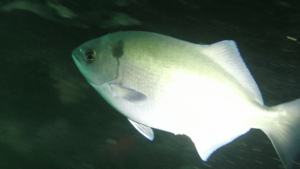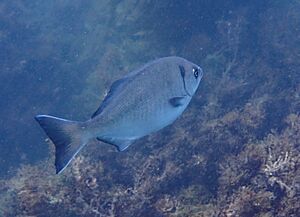Halfmoon facts for kids
Quick facts for kids Halfmoon |
|
|---|---|
 |
|
| Conservation status | |
| Scientific classification | |
| Synonyms | |
|
The halfmoon (Medialuna californiensis), also called the blue perch, is a cool fish that lives in the ocean. It's a type of ray-finned fish and belongs to a group called sea chubs. You can find these fish along the coasts of western North America in the eastern Pacific Ocean. People like to catch them with fishing rods because they are good to eat!
Contents
What Does the Halfmoon Look Like?
The halfmoon fish has a body that is long, flat, and oval-shaped. It has a small, pointed head. Its mouth is small and horizontal. When the mouth is closed, the upper jaw is partly hidden. Each jaw has one row of pointed teeth.
This fish has a long fin on its back called a dorsal fin. The front part has 9 to 11 stiff spines that can fold down. The back part has 22 to 27 soft rays, which are taller than the spines. The fin on its belly, called the anal fin, has 3 spines and 17 to 21 soft rays. The tail fin, or caudal fin, is slightly curved inward.
Most of the halfmoon's head and body are covered in small, thick, and rough scales. The area in front of its eyes does not have scales. The fish is dark bluish-grey or grey on top. Its belly is lighter in color. Sometimes, you might see faint, narrow stripes along its sides. It also has a dark spot on the top corner of its gill cover.
The edges of its dorsal, anal, and tail fins are dark. The outer edge of each part of its tail fin is white. Young halfmoon fish are blue on top and silvery underneath. The biggest halfmoon ever recorded was about 48 centimeters (19 inches) long. Its tail fin looks a bit like a crescent moon, which is how it got its name!
Where Do Halfmoon Fish Live?
The halfmoon fish lives in the eastern Pacific Ocean. You can find them along the western coast of North America. Their range goes from Vancouver Island in the north down to the Gulf of California. However, they are not very common north of Point Conception in California.
Halfmoon Habitat and Life
Halfmoon fish often swim high up in the water near rocks. They also like to be in the middle depths of kelp forests. Their favorite places to live include rocky reefs, kelp forests, and even around oil rigs. Sometimes, they are seen near the water's surface. But they are usually found at depths between 3 and 40 meters (10 to 130 feet).
These fish are omnivorous, meaning they eat both plants and animals. Their main diet includes kelp, red algae, and green algae. They also eat small creatures like crustaceans, sponges, and sea anemones. Halfmoon fish usually swim together in groups called schools.
Young halfmoon fish are sometimes found far out in the ocean. But they are more common in shallow areas and kelp beds, just like the adults. When they are very young, they can be as small as 2.54 centimeters (1 inch). At this size, they might swim in schools of a dozen or more fish. You can find them on the outer edges of kelp beds and in sea grass beds.
Halfmoon fish become old enough to have babies when they are about 20 centimeters (8 inches) long. This usually happens when they are around two years old. They lay their eggs from June to October. The eggs and newly hatched babies float in the water as plankton. Many young halfmoon fish are found off northern Baja California. Young halfmoon fish sometimes school with young opaleye fish under floating rafts of kelp.
Fishing for Halfmoon Fish
The halfmoon is a popular fish for people who enjoy fishing with a rod and line. Sometimes, they are also caught by accident in traps and bait nets. In California, you can fish for them from August to April. The meat of the halfmoon fish has a light flavor. You can eat them as fillets or cooked whole in many different ways.
About the Halfmoon's Name
The halfmoon fish was first officially described in 1876. An Austrian fish expert named Franz Steindachner gave it the scientific name Scorpis californiensis. He found the first one in San Diego, California.



